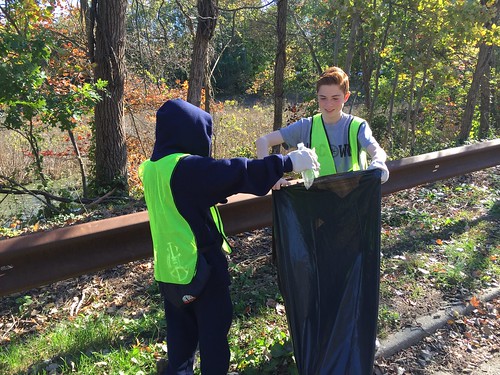FOR IMMEDIATE RELEASE 16-106 October 14, 2016 deppressoffice@dep.nyc.gov, (718) 595-6600 New York City Public School Students Help Clean up Staten Island BluebeltMore Than 30 Students from Gaynor McCown Expeditionary Learning High School Gathered at Wolfe’s Pond Bluebelt to Remove Litter for ‘Day of Service’Photos of the Event are Available on DEP’s Flickr PageThe New York City Department of Environmental Protection (DEP) today joined with more than 30 students from the Gaynor McCown Expeditionary Learning High School on Staten Island to help clean up Wolfe’s Pond Bluebelt in the Prince’s Bay neighborhood. The collaborative community service project is in its fourth year and prepares students to become environmental stewards for the Island’s Bluebelts. “Encouraging young New Yorkers to care for the Bluebelts teaches them to both protect and respect these precious ecosystems that also serve as critical drainage infrastructure for surrounding communities,” said DEP Acting Commissioner Vincent Sapienza. “The Bluebelt is an innovative and sustainable approach to managing stormwater and reducing flooding. We thank the students and staff from Gaynor McCown for their commitment to keeping Staten Island clean and free from litter.” The Wolfe’s Pond Bluebelt collects stormwater from a drainage area of approximately 589 acres. The Bluebelt consists of two constructed holding basins and a weir to control the stormwater. The Bluebelt also serves as an important open space and habitat for the Island’s diverse wildlife. On Staten Island, DEP has connected thousands of homes to the City’s wastewater treatment system, eliminating the need for septic tanks, and preserved or constructed more than 60 Bluebelt wetlands to reduce roadway flooding and improve harbor water quality. Staten Island residents can play a vital role in supporting the Bluebelt by helping to keep streams and wetlands pristine and by protecting them from pollution. Get involved:
DEP manages New York City’s water supply, providing more than one billion gallons of water each day to more than nine million residents, including eight million in New York City. The water is delivered from a watershed that extends more than 125 miles from the city, comprising 19 reservoirs and three controlled lakes. Approximately 7,000 miles of water mains, tunnels and aqueducts bring water to homes and businesses throughout the five boroughs, and 7,500 miles of sewer lines and 96 pump stations take wastewater to 14 in-city treatment plants. DEP has nearly 6,000 employees, including almost 1,000 in the upstate watershed. In addition, DEP has a robust capital program, with a planned $14 billion in investments over the next 10 years that will create up to 3,000 construction-related jobs per year. This capital program is responsible for critical projects like City Water Tunnel No. 3; the Staten Island Bluebelt program, an ecologically sound and cost-effective stormwater management system; the city’s Watershed Protection Program, which protects sensitive lands upstate near the city’s reservoirs in order to maintain their high water quality; and the installation of more than 820,000 Automated Meter Reading devices, which will allow customers to track their daily water use, more easily manage their accounts and be alerted to potential leaks on their properties. For more information, visit nyc.gov/dep, like us on Facebook, or follow us on Twitter. | ||
